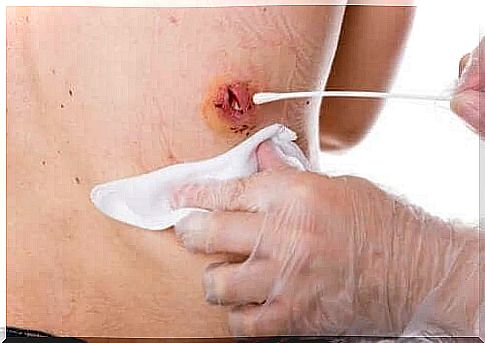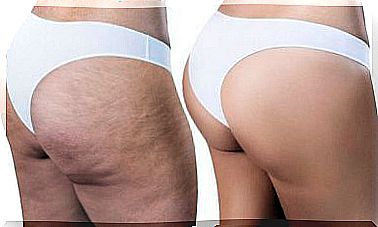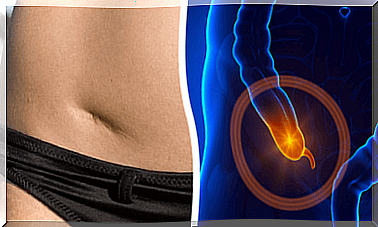Causes And Treatments For Epidermal Cysts

Epidermal cysts are small, benign nodules on the skin. Their location varies, but they mainly appear on the face, neck and trunk.
These types of cysts grow slowly and are rarely painful. They cause discomfort only in exceptional cases and therefore do not require treatment. In this article we will tell you more about the main causes and then we will discuss the available treatments for these unsightly spots on the skin.
What Causes Epidermal Cysts?
The epidermis, the most superficial layer of the skin, consists of a thin surface that protects cells that are constantly changing. In most cases, epidermal cysts develop when cells in the epidermis are not shed properly and instead continue to multiply.
They can even be deeper in the skin. Another cause of their appearance is a skin lesion or irritation of the most superficial part of a hair follicle.
The walls of this type of cyst are formed by the cells of the epidermis, and keratin then secretes into the cyst. In this way, damage to a hair follicle or sebaceous gland in the skin can then lead to abnormal growth of epidermal cells.
Symptoms of Epidermal Cysts

Epidermal cysts do not manifest with too many symptoms, but they do have some distinct features, such as:
- A visible small, round bump under the skin of the face, neck, or trunk.
- The central opening of the cyst is blocked by a black blackhead.
- The area of skin may turn red if the cyst becomes infected or inflamed and there is increased tenderness and inflammation.
- A thick, yellow, foul-smelling liquid (pus) may run out when opened.
BQ If skin cells do not shed normally, an epidermoid cyst can form.
When should you see a doctor?
Most epidermal cysts do not lead to further health problems and do not require treatment. Seek immediate help if you notice any of the following:
Rapid growth of the bump.
- The bump has burst, causing pain or other signs of infection.
- The epidermoid cyst settles in an area that is always irritated.
- It causes discomfort for aesthetic reasons.
- It is located on an unusual part of the body, such as the fingers.
- If there is a fever.
Risk Factors for Epidermal Cysts
Anyone can develop one or more epidermal cysts, but puberty can affect the appearance of these bumps. Men are more likely to develop them. This also applies to people with:
- the Gardner syndrome.
- the basal cell nevus syndrome.
- pachyonychia congenita type II.
Possible complications
Complications from epidermoid cysts are uncommon. In the rare cases where this is the case, the following problems can occur:
- inflammation.
- Painful infection and abscesses.
- The opening of the bump, caused by trauma or by a bacterial infection caused by Staphylococcus aureus, Escherichia coli and group A Streptococcus.
- skin cancer. A study shows that 1% of cysts undergo a malignant transformation into basal cell carcinoma or squamous cell carcinoma.
Diagnosis of Epidermal Cysts
Doctors should be able to make a diagnosis simply by looking at the cyst and then evaluating it. It resembles a clogged sebaceous gland, but they are not due to the same pathology.
The cause of epidermal cysts is damage to the hair follicles or the outer layer of the skin. So a doctor will request a biopsy to rule out other conditions if they don’t trust the situation.
Differential diagnosis
There are several conditions that are very similar to this form of cyst. Some of the similar issues to consider when making the diagnosis include:
- Dermoid cysts
- Lipomas
- Pseudocysts of acne
- Myxoid pseudocysts
Treatment of epidermal cysts
Epidermal cysts usually don’t need treatment unless they cause discomfort for some reason. This includes:
- the location on the body.
- aesthetic reasons.
- the recurrence of infections.
Below we will discuss the main therapeutic options available when the patient and physician agree that intervention is necessary or desirable.
Incision and Drainage

Incision drainage is one of the first choice treatments for epidermal cysts. This treatment starts with making a cut in the cyst.
Then they apply a light manual pressure to squeeze the liquid out. This procedure is quick and easy, but the cyst can return over time if the doctor doesn’t do it right.
In addition, they should know that it is necessary to extract the contents of the entire cyst. This also applies to the cell wall of the cyst. Otherwise, the cyst will re-form over time.
Minor surgery
This treatment requires a specialist who can remove the entire cyst, including the cells from the wall of the cyst. A study published in the journal Medical Sciences describes the importance of removing the entire cell wall of the cyst to reduce the chance of a recurrence of a bump developing.
A patient undergoing this procedure will likely need to return a few days later to have the suture removed. This procedure is small, but prevents regrowth in the same area.
In cases where there is an inflammation or infection of the cyst, a doctor should carry out the necessary treatment and then plan an operation.
Treatment with medication
Another treatment consists of injecting a corticosteroid into the cyst area. The doctor can choose this if there is a large swelling or inflammation.
Antibiotics
There are situations where the presence of a major infection is obvious. In that case, a doctor will initially prescribe an oral antibiotic treatment. They will evaluate other therapeutic options once the infection subsides.
A tumor is not necessarily malignant
Epidermal cysts are actually benign skin tumors. In fact, they are very common and usually do not require medical treatment as long as there are no annoying symptoms. Do not try to remove them yourself to avoid infection and further complications.









